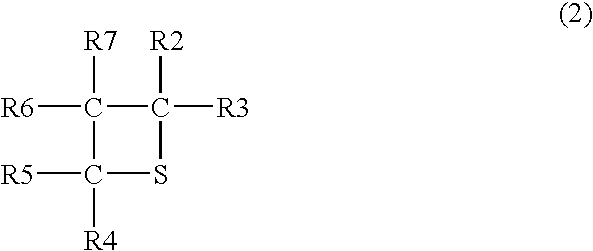Polymerizable composition containing novel cyclic sulfur compound and resin obtained by curing the polymerizable composition
a polymerizable composition and sulfur compound technology, applied in the field of sulfur-containing cyclic compounds, can solve the problems of low practicability of methods, decrease of crosslinking properties of resins, and low heat resistance, and achieve excellent optical physical properties, high abbe's number, and high refractive index
- Summary
- Abstract
- Description
- Claims
- Application Information
AI Technical Summary
Benefits of technology
Problems solved by technology
Method used
Image
Examples
example 1
[0142]190 g of thiourea, 253 g of 35% hydrochloric acid, and 250 g of water were charged in a reactor provided with a stirrer and thermometer, and then 156 g of 3-thietanol was added dropwisely to the resultant mixture under stirring. The mixture was further stirred at 30° C. for 24 hours for aging. Then, 177 g of 24% ammonia water was added dropwisely to the mixture maintained at 30° C., and then stirred at 30° C. for 15 hours for aging. After still standing, 134 g of a lower layer was removed as an organic layer. The thus-removed lower layer was simply distilled under reduced pressure to recover a distillate of 40° C. under 106 Pa. As a result, 69 g of distillate was obtained, and the distillate was 3-mercaptothietane (referred to as “compound A” hereinafter).
[0143]The identification data of compound A is shown below.
[0144]
TABLE 1Elemental AnalysisCHSTheoretical33.9%5.7%60.4%valueAnalytical34.2%5.1%60.7%valueMS spectrum (EIM+ = 106method)IR spectrum642 cm−1; sulfide2539 cm−1; merc...
example 2
[0145]163 g of 3-chlorothietane (referred to as “compound B” hereinafter) and 200 g of toluene were charged in a reactor provided with a stirrer and thermometer, and then a sodium sulfide aqueous solution obtained by reacting 60 g of 70% sodium hydrosulfide, 60 g of water and 62 g of 49% caustic soda was added dropwisely to the resultant mixture under stirring at 5° C. After aging for 2 hours, the resultant toluene layer was washed with acetic acid and a salt aqueous solution, dehydrated with magnesium sulfate, and then concentrated to obtain 135 g of concentration residue. The thus-obtained residue was purified by silica gel chromatography using hexane and chloroform as developing solvents. As a result of analysis, 84 g of bis(3-thietanyl) sulfide (referred to as “compound C” hereinafter) was obtained. The stability of the thus-obtain compound C was evaluated as ◯ (good).
[0146]The identification data of compound C is shown below.
[0147]
TABLE 2Elemental AnalysisCHSTheoretical40.5%5.6...
example 3
[0148]159 g of compound A and 20 g of toluene were charged in a reactor provided with a stirrer and thermometer, and then 890 g of 12.7% sodium hypochlorite aqueous solution was added dropwisely to the resultant mixture under stirring at 10° C. After aging at 10° C. for 2 hours, the resultant toluene layer was washed twice with a salt aqueous solution, dehydrated with magnesium sulfate, filtered, and then concentrated to obtain 148 g of concentration residue. The thus-obtained residue was purified by silica gel chromatography using hexane and chloroform as developing solvents. As a result of analysis, the residue was bis(3-thietanyl) disulfide (referred to as “compound D” hereinafter). The stability of the thus-obtain compound D was evaluated as ◯ (good).
[0149]The identification data of compound D is shown below.
[0150]
TABLE 3Elemental analysisCHSTheoretical34.2%4.8%61.0%valueAnalytical34.8%5.1%60.1%valueMS spectrum (EIM+ = 210method)IR spectrum650 cm−1; sulfide1H-NMR spectruma; 3.2 ...
PUM
| Property | Measurement | Unit |
|---|---|---|
| refractive index | aaaaa | aaaaa |
| temperature | aaaaa | aaaaa |
| temperature | aaaaa | aaaaa |
Abstract
Description
Claims
Application Information
 Login to View More
Login to View More - R&D
- Intellectual Property
- Life Sciences
- Materials
- Tech Scout
- Unparalleled Data Quality
- Higher Quality Content
- 60% Fewer Hallucinations
Browse by: Latest US Patents, China's latest patents, Technical Efficacy Thesaurus, Application Domain, Technology Topic, Popular Technical Reports.
© 2025 PatSnap. All rights reserved.Legal|Privacy policy|Modern Slavery Act Transparency Statement|Sitemap|About US| Contact US: help@patsnap.com



